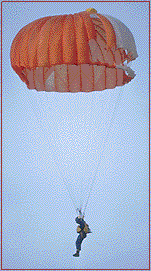
|
Terminal Velocity Terminal velocity
is the maximum velocity that a particular body can reach when falling
through the air. Without air resistance, a body would continue to
accelerate towards infinity. Only a collision with a body, say the
earth, would slow Joe down without air resistance. Terminal velocity
varies between different kinds of bodies. For instance, a feather,
released from a very tall building, will fall much slower and reach
a terminal velocity much sooner than that of an elephant. Gravity
is acting equally on both of these objects, but because of the greater
surface area to mass ratio of the feather, the feather reaches its
terminal velocity much sooner. Here is an example of how air resistance affects two different bodies.
Interestingly
enough, one can actually change their "terminal" velocity.
For instance, if Joe were to jump out of the plane and position
in the prone, spread eagle position, his surface area would be at
his maximum. Thus the terminal velocity he would reach would be
lower than the terminal velocity he would reach if he dove from
the plane head first. When Joe transitions from spread eagle to
the head first position, his surface area decreases, thus allowing
for an increase in speed.  (http://www.smm.org/sln/tf/d/dandelion/parachute.gif) With the knowledge of these concepts of physics, one should now be able (with training) to safely partake in skydiving. A safe landing should not be an issue! |
